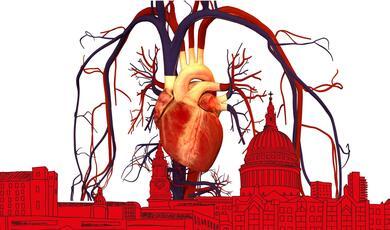New directions for home treatment of eating disorders
Share
- Details
- Text
- Audio
- Downloads
- Extra Reading
Professor Janet Treasure PhD FRCP FRCPsych, Department of Academic Psychiatry
Download Text
NEW DIRECTIONS FOR HOME TREATMENT OF EATING DISORDERS
Professor Janet Treasure
I am going to mainly talk, first of all, from the perspective of my patients, to let you know more about eating disorders. What I am going to cover in the lecture tonight is talking about what is an eating disorder, and that will be very much the voices of people with an eating disorder; discussing mixed feelings, because these are a critical component of eating disorders. I am going to talk a little bit about the history; a bit about what they are; some myths and misperceptions about them; a little bit about causes; and new approaches to treatment.
There is a rather unusual phenomenon, for any illness, which is the pro-anorexia websites, websites that promote anorexia nervosa thought. There’s a variety of sites that are constantly shut down, but they seem constantly to come up again. The aspects of the pro-anorexia sites are things they cover. They also have pictures of food, food porn, lists of safe foods, tricks about how to reduce calorie intake, and as inspiration some very thin images, and helping people with eating order with their positive aspects about the illness, some of the strategies that are used to be able to suppress the drives of hunger – ‘thou shalt not eat without feeling guilty, nothing tastes as thin feels, hunger hurts, what nourishes me destroys me.’
I hope that this introduction has illustrated to you some of the feelings that are there in people with eating disorders. There are mixed feelings within the individual herself: these positive anorexia thoughts, the idea that eating disorder is a solution, helping to suppress these emotions, and anorexia can easily mesh with a person’s core values. Then on the other side, we have society, family, help services, that try sometimes to do the opposite, but of course, some of these influences can be rather mixed. So society can have rather mixed feelings about anorexia.
Food has many meanings for us. The main one from the past was something that we enjoyed with other people but, more recently, because of our abundance of food, we are having negative views about it. Food gets linked to moral values and worth, and of course shape also has been linked with values.
Eating disorders have been around for a long time, but have been framed in different ways over time. In the 1600s, some people who sound very much like modern day people with anorexia nervosa were holy saints. There was St Catherine of Sienna and several others. There is a book describing a lot of these, and they often gave the explanations to other people that they were not eating because it made them feel closer to God. Then as we move over time, people will perhaps lose the idea of a religious significance of anorexia, and it becomes more of this scientific, freakish curiosity. There was a fasting girl, Martha Taylor, who lived near Chatsworth, and the grand people from Chatsworth would go and see her. She didn’t seem to need to eat. There were several causes of such girls. Of course, we should not be so surprised; we had David Blane recently, above the Thames, in a similar way. This is something that has profound effects on us.
It was not until the 1860s that it was described as an illness, by Sir William Gull at Guy’s Hospital. Perhaps one of the reasons was that some of the nurses from Guy’s had gone to make sure one of a fasting maid, somebody from Wales, didn’t eat, and they were so good at their job that in fact this poor girl died, because obviously she was eating small amounts.
When Sir William Gull described eating disorders, we had the condition of restricting anorexia nervosa, where people mainly stop eating, or reduce the amount they eat, but the next historical landmark is Professor Gerald Russell, who, in 1979, wrote a paper describing bulimia nervosa, and he gave this condition his name. Since that time, we’ve had a variety of sub-types of eating disorder: binge, purge, anorexia, purging. They are all slight variations of the theme. Some people think we should lump them altogether, but you can see that they are slowly edging towards obesity, and obesity itself was considered more of a psychiatric illness in the Fifties and treated with analysis.
In the UK there is an excellent database from all people who go to their General Practitioners, and it covers a large amount of the country. It has only been running since the Eighties, but you can clearly see trends and they are quite reliable. Anorexia nervosa is constant over time, whereas there was a marked rise in the early Nineties of the incidence of new cases going to their GP for treatment for bulimia nervosa. Some researchers from America have gone through all the studies that have looked at the different levels, the numbers of eating disorders, in different cultures, in different time periods. What they have found is that anorexia does not seem to changeThere does not seem to be a marked variation in the amount of anorexia, even across different countries, whereas bulimia does show great differences. So bulimia nervosa is what we call in psychiatry a culture-bound syndrome. There is something in the culture that can make this illness happen and develop. Naomi Wolf, in a very interesting book, wrote that she thought that now, in the 20th Century, food had replaced sex as the neurotic focus of everyday life.
Let’s just look at some of often the stereotypes and misperceptions about eating disorders. Often there is an idea that they are just a silly teenage condition. However, my data shows that in our clinical population, which is in South-East London, most people come to us on average at 28 years, some as young as14 - though we have even had people as old as 80 in our service - but they are at the young end of the spectrum, and we don’t take the very young because we are more of an adult service. There is often a feeling that they are just white middle class girls, but in fact we do get people across the range of cultures. In studies where they have counted different psychiatric conditions in the community, they are not that different to bipolar disorder or any form of psychotic disorder, especially when you realise that they mainly are there in women, 10 to one women to men. Some people dismiss eating disorders as just girls with a mild problem, the ‘worried well’, whereas in fact it has got the highest mortality of any psychiatric condition, and it tends nowadays to be the one psychiatric condition where the stays are the longest.
Eating disorders fit within the spectrum of various forms of psychiatric disease. There is often a lot of crossover between what we call anorexia bulimia and what we call “eating disorder not otherwise specified”,or doesn’t exactly meet these criteria. Anorexia can be very similar to obsessive compulsive disorder, and even autistic disorder, whereas the bulimic disorders tend to be associated more with the emotional disorders, bipolar disorder, effective disorder, some more with addictions, and even ADHD. We think that there are genetic factors, and they are very potent in terms of increasing the risk.
In terms of anorexia nervosa, there is a lot of evidence now that being rather small for gestational age or early birth problems puts you at risk. Sometimes feeding problems slightly increase the risk. Sometimes, for example, attention to detail, or attention to symmetry, is part of the personality that increases the risk for anorexia. Then puberty, with its emotional developments and cognitive developments, seems to be something that triggers it off.
We have got some things that are similar, and some things that are different, for bulimia nervosa. We have got the genes still. A tendency to be overweight increases the risk, and especially being teased and tormented or criticised about your weight and shape or eating. General childhood adversity, and, as I discussed before, these cultural issues relating to shape and weight and the meaning of food are particularly important for bulimia.
What happens to the brain in terms of eating disorder? What happens to the brain when you see food? There has been quite a lot of interest in this. Nina Jackson, whose daughter has anorexia nervosa, is particularly very interested in our research in this area. What we find is that the brain does react very differently to food in people who have had eating disorders. The orbital frontal cortex and the anterior singulet are abnormally over-activated in people with both anorexia and bulimia nervosa.
In people who have made a long-term recovery from their illness, we find that they get the same activation to food, abnormal activation, as people who are currently ill with an eating disorder, but they have some changes. They first of all get the same area activated as normals have activated when you see food but also they seem to have to develop new pathways, perhaps to suppress what is happening, because they get extra activation. This illustrates how this episode of starvation can have profound effects on the way that the brain manages to process images of food, and we know that the brain plays a key role in altering hunger and satiety.
What about other aspects of the brain? What about the thinking process? We have been doing a lot of work, mainly inspired by our patients themselves, to think it is perhaps not what people are thinking, it is not just thinking about food or shape, it is about how they think. I had one of my patients write to me and say, “I’m reading this book, Curious Incidents in the Dark of the Night, and I see very similar patterns between the boy depicted in that and me myself.” She even went so far as to make me a beautiful table describing this, and doing a comparing and contrasting of the thought patterns that were present in that young boy and what she saw in herself and others with eating disorders, such as a need for a routine, and she noticed that she had to eat in a set time every day, and found any change of routine extremely difficult. She read in the book about the obsession with certain colours and numbers, and she noted how she had to eat or leave three of everything. The boy in the book only ate foods that were not touching on the plate; she would only eat things that were broken. He found eating from places he did not know difficult, and often people with eating disorder are very frightened of having food prepared by other people. He minutely analysed things, and she recognises that this was something that she did – obsessive behaviours, having furniture placed. Again, she recognised that she had a lot of these – washing up before she would eat, calorie counting, concerns about fluctuation in weight, and her exercise addition. Extreme reactions, this magical thinking, seeing yellow cars as meaning it is going to be a bad day, and she herself recognised that any break of the ordinary was very difficult, and if something bad happens, the immediate reaction is not eating, and of course she had exactly the same pattern of reacting.
We were very interested in this, because it did tie in with a lot of work we were doing looking at these personality traits. Of course this young boy in the book had autistic disorder, and there has been a professor in Sweden who has commented that a proportion of patients with eating disorders are very like people with autistic disorder. That led us to think about how information is processed, and we have been using various neuro-psychological tests that are able to give us information about this. So the tests include looking at a diagram, then having to copy it out after you have not seen it for five minutes, so reproducing it from your memory. People with anorexia nervosa do not score very well on this task. On the other hand, they score brilliantly at another task, which is called the embedded figure task, which is where you try and find within a complicated design a shape or different shapes, and people with anorexia nervosa are twice as fast as the general population. So we find that there are certain forms of information processing that people with anorexia nervosa are either poor at, such as being able to remember such a complicated design, or very good at, for example being able to analyse a design.
We have talked about some of the basic background of eating disorders, and we will now move on to thinking about treatments for anorexia nervosa. Where are we with treatments? Well, not very far. There have been the nice guidelines. As you probably know, these are produced by a committee got together by the Government to try and review all treatments of any condition that is put to a panel, and the eating disorders were subject to such an analysis a few years ago, and the nice guidelines came out two years ago. However, it was rather difficult, because there was very little evidence on which this committee could make any conclusions. Even of the studies that were there, it was very difficult to put them together and produce an overview, mainly because the type of cases that were included were very different, either very young people, early in the course of their illness, or older people who had had ten years of illness, people who were very, very poorly and very ill, could hardly walk, whereas some others were working. The treatments have not been well designed and we have not had very big treatments. However, the one thing we do know is that family involvement is useful for younger people. That was one study – it’s not very strong evidence. On the other hand, we do know quite a bit, from following cases of anorexia nervosa, about what makes changing from this illness so difficult.
Sir William Gull was able to write up, in many of the medical journals, how he treated his cases, and so you see he was able to treat a case of a young girl with what he called anorexia nervosa. His first search for a name was apepsia hysterica, because he thought it was a sort of hysterical illness, the fact that it occurred in women, and he thought that it perhaps was the stomach not working properly, but then he changed it to anorexia nervosa, recognising that it probably was related to something in the mind. His advice was very simple: warm clothing, nourishing food, and stopping any exercise. He was writing to a doctor in the Isle of Wight, and that doctor had difficulty implementing his treatment recommendations. It was not easy keeping the patient quiet or making her eat and drink. Every step had to be fought. She was most loquacious and obstinate, anxious to exert herself bodily and mentally. I think those of you who know people with eating disorders would recognise some of the difficulties that can emerge when you try and help people to gain weight. But this patient, treated at home, was able to get better very quickly, well within a year.
There was a phase then when people were admitted to hospital, but one of the first steps of trying to get back perhaps to what Sir William Gull had discovered was the Maudesley method of family therapy. If you remember, when I was talking about nice guidelines, this was one where we have some evidence in studies that it works. What is very important for treatment, so that it can be given elsewhere, is that it has been written into a book, so therapists all over the world know how to deliver it. So there are many studies now being repeated using this method elsewhere because they can read the manual. It clearly indicated how families can be very important in any early. It also has been shown that the need for in-patient care, the need for putting people into hospital, is not as necessary for people who have a good prognosis, and that’s usually the very early cases.
We have data from the early study of this Maudersley family therapy. All the people were admitted to hospital first off, because that was the standard, and then had a year of treatment afterwards, either the family therapy, or individual therapy. In eating disorder, change does not occur early, and you have to look over the long term. What they did, which was very useful, was divided the cases up before they were randomised, allocated by chance to these two treatments, into different groups. Those people who have not had a very long illness and are still quite young do very well after a year and continue to do very well after five years, much better than those just having individual therapy alone, who do not do as well, and the most important thing is that they don’t catch up after five years. If you don’t have early effective treatment, it can stunt your further recovery for a long time, so this is a very clear sign that early intervention is very important, and early intervention involving the family is so important, whereas when people have had the illness over three years, it is very difficult to get much change and there is less difference. We studied a group who were over 18 years old - a mixed group. They are people who started to have the illness after 18 or have had it for a very long time, so there are over 18 and may have started at 15. There is perhaps a hint that they might do slightly better with the individual therapy.
What we now need to do, very urgently, is to try and find treatments for people who are treatment-resistant: people who have had treatment for a long time, or had the family treatment, and it has not really helped. The most important thing though is that we tailor our treatments, rather than just taking off-the-peg treatments, therapies, that are used for other conditions, because if we can know what is keeping the illness going, we might be able to specifically work on that and produce change.
What we have to consider in treatment is that one of the things that keeps it going are pro-anorexia thoughts, which means that people do not want to change, and that can be an important step. We might know what they need to do, but we cannot get them to take the therapy, and either that’s actively not taking the therapy or not changing. Recently there was produced a so-called wonder drug, Fluoxitine, and it was thought that could help people with eating disorders. It was very hard to get people for the trial. They screened nearly 700 to get 122 to take part in this study. People quickly drop out of the study by 12 weeks, and by 6 weeks, only 50% of those given anti-depressants stay in treatment. So it is very difficult for people with eating disorders to accept treatments, especially ones that they do not feel are right for them.
We know quite a bit about understanding how people think about changing behaviour. All of us, if we have to change any behaviour, go through various stages, but it is unusual for people to go to doctors and not be in wanting having something done. Normally when you go to see a doctor, you want a pill or you want to get better, whereas people with anorexia nervosa, they come to medical help because other people see that they are ill. Even when they don’t want help, other people are wanting something to happen, and so that is why treatment is so difficult.
People in pre-contemplation say they do not need to change, they don’t have a problem. They have more mixed feelings when they get to contemplation, and it is only worth telling people what to do when they are in action. That is an important thing to remember with people with eating disorders: they are not ready to change.
We have to think about how to help people who are not ready to change. If you tell them what to do and confront them, it doesn’t work. You have to use other strategies and try and understand from that individual why change might be important to them, and also make them realise that they can change, that they have the confidence to change, and that might mean, if we go back to that first case, the girl who was so frightened of her emotions, trying to help her accept her emotions. We need to loosen the hold of any factors that keep it going.
The way we react is important. This is the way we act as therapists, or the way we act as family members trying to help people with eating disorders get over their problem. There is a tendency for people to react in extremes, and we use animal metaphors to warn ourselves, because this happens on our in-patient units and in our out-patient care, and it also happens with families. There is either a tendency to over-protect and take over and look after, walk on eggshells, and not allow the person with the eating disorder to make any decisions or develop; or on the other hand, there is a tendency to be rather directive, to try and lecture and argue. We try and make sure we are in the middle position, what we call the dolphin position, where we can nudge someone into safety. Another metaphor that it is useful to remember is that someone with an eating disorder is rather like somebody at sea, and their eating disorder is like a lifebelt. It is a solution for them and it makes them feel safe, so they ae not going to take that off unless they can be in a position of more safety. This is the way we have to try and nudge people into recovery.
One of the strategies that we use in treatment is motivational interviewing, because that is a very good way of moving people round these stages of change. I don’t know how many of you know Colombo, but his methods would be very much the methods we advocate, having a low power position. We use the metaphor Aesop’s Fable. When trying to change somebody with an eating disorder, there is no point being like the North Wind where you blow and insist that they change, because they will only fasten up their eating disorder more tightly, and you need to be more like the Sun, so that they will take their anorexia off on their own volition.
What about other maintaining factors? There can be family factors. If we go back to those causes I was talking about, there can be a style of thinking which makes them rather rigid or get rather preoccupied with detail, and wanting to avoid emotion. We work a lot with parents, trying to help them facilitate change. That involves trying to stop some of the reflex things that can happen because you are so concerned about somebody with an eating disorder. So we try and help parents not be too over-protective, such as being as a kangaroo, or being too critical, and not themselves to get so anxious, because that increases their daughter’s anxiety and it can make things even worse. So we teach parents to be calm, compassionate and consistent. We try and help parents not fall into any enabling behaviours. It is so easy to be giving reassurance when somebody is asking you 100 times, “Have I eaten too much?” “Am I looking too fat?” You want to make them feel better, and it’s so easy to say, “No, you haven’t eaten too much,” but that keeps the whole thing going. That’s one of the enabling behaviours, but there are many others. We try and help people with anorexia nervosa develop these traits and behaviours that go against some of the things that make them at risk, and so help them to be more flexible, help them to be more emotionally intelligent, help them to be less rigid, and not to focus on detail or to avoid emotions.
In therapy, we do work at trying to get them to understand these different perspectives, the fact that some of them do have this rather extreme type of personality, but they need also to be able at times to move to the bigger picture, which might mean ignoring some of the details. Similarly, we try and help them get different perspectives on the use of emotion. There is a tendency for somebody with anorexia nervosa to be like an ice maiden, devoid of any emotion, sitting alone on the iceberg, and we try and help them to use their emotions to connect with others in the world.
I hope I have shown you how we can now be developing new treatments for eating disorders by focusing on these factors that can keep the eating going, and we are now developing workshops where we can teach carers the skills that we have learnt in the specialist units, so we hope that family members can deliver early interventions which we know are so important, because once the illness has progressed for a long time, you get a lot of secondary effects, changes in the brain, for example, that make change difficult. We need to concentrate not just on the content of what people say, but how they think; to try to enable them to have different strategies of thinking, and use remediation in this, and show them how to use their emotions. Culture does shape the form and behaviour of discontent, and that very much has shaped the development of bulimia nervosa that started mainly in women born after the Fifties. It can have a big impact on the maintenance of anorexia nervosa, but what we now think is that the main mechanisms causing these eating disorders are interactions between the genes and the environment that can interact with brain mechanisms, or produce brain mechanisms, that can keep the illness going.
©Professor Janet Treasure, Gresham College, 14 February 2006
This event was on Tue, 14 Feb 2006
Support Gresham
Gresham College has offered an outstanding education to the public free of charge for over 400 years. Today, Gresham College plays an important role in fostering a love of learning and a greater understanding of ourselves and the world around us. Your donation will help to widen our reach and to broaden our audience, allowing more people to benefit from a high-quality education from some of the brightest minds.


 Login
Login







